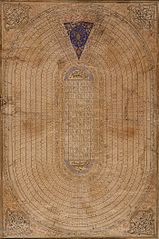
India, 1891
Wikimedia Commons:
LA County Museum of Art
Today is al-Hijra – New Year’s Day according to the Islamic calendar. The Islamic calendar began in 622 CE, so happy 1435! As an interfaith educator, I’m always amazed at how many New Year’s days there are. The Jewish New Year was on September 5th this year, marking the beginning of the year 5774. For Buddhists, New Year’s Day might be on the first full moon in January, the first full moon in April, or somewhere in between. Hindu New Year’s days also vary, although many Hindus celebrate at some point during mid-April. For most Christians, our civil calendar is our religious calendar, so New Year’s Day is always January 1st. However, for many Eastern Orthodox Christians, New Year’s Day, 2013 was on January 14th.
All these variations arise because of different calendars. The Islamic calendar is based solely on the moon, which means there are 12 months/lunar cycles, and a year has either 354 or 355 days (instead of 365). It also means that New Year’s Day seems to move around every year. This year, al-Hijra was on November 5th. Next year, it’s on October 25th. In 2020, al-Hijra will be on August 21st. As in Judaism, holidays begin the day before as sundown, so perhaps it’s more accurate to say that al-Hijra started on November 4th.
Year 0 also occurs at different times for different calendars, often marking an important event in that religion’s history. Year 0 for our calendar, the Gregorian calendar, is based on the birth of Jesus. Year 0 for Buddhist calendars is based on the year Buddha attained Enlightenment. The Jewish calendar begins with God’s creation of man, defined as Day 6 in the Genesis creation story found in Chapter 1. And Hindu calendars generally begin with Krishna’s ascension into heaven.
Year 0 for the Islamic calendar is 622 CE. It marks the year when Muhammad and some of his followers escaped Mecca after it became too dangerous to remain there. Muhammad received his first revelations from the angel Gabriel in 610 CE at the age of 40. Soon after, he began preaching publicly, warning unbelievers of their impending punishment while offering hope to those who served and worshipped God. He also condemned idol worship and polytheism, angering most of the local financial and political leaders of the day. Over time, life in Mecca became increasingly perilous for Muhammad and his followers. By 622 CE, at the age of 52, Muhammad knew it was time to leave. He found protection for himself, his followers, and his new religion in the community of Yathrib, a city about 200 miles north of Mecca. Yathrib was renamed the City of the Prophet, which was eventually shorted to just “the city.” We now know it as Medina.
Muslims celebrate al-Hijra in a variety of ways, but it doesn’t look anything like New Year’s Day in Times Square. Many Muslims mark the holiday as a special day of prayer, retelling the story of the migration to Medina. Others treat it as a time to reflect on the past year, to release the negative in one’s life, to recommit to a more faithful life, or to simply make New Year’s resolutions. For Shia Muslims, al-Hijra is important because it marks the first day of the first month, Muharram. During the first 10 days of the month, Shia Muslims commemorate the death of Muhammad’s grandson, his family, and his followers by an early Muslim caliph.
New Year’s days are always good for starting over in some way. And sometimes, we need more than one of them in a year. As Jimmy Buffet and Alan Jackson reminded us, “it’s five o’clock somewhere.” Perhaps it would be more helpful to remember that it might be New Year’s Day somewhere, too.